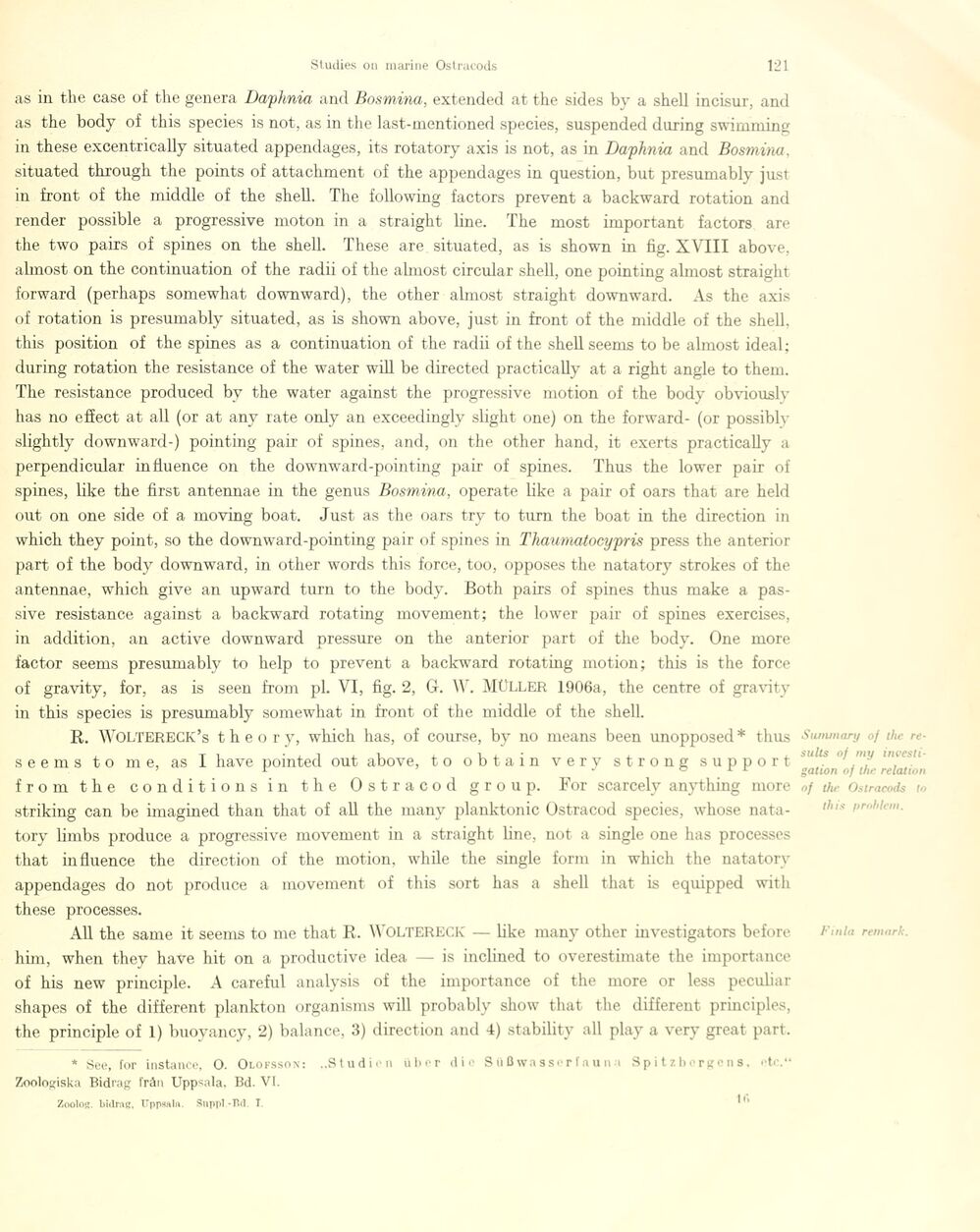
Full resolution (JPEG) - On this page / på denna sida - Sidor ...

<< prev. page << föreg. sida << >> nästa sida >> next page >>
Below is the raw OCR text
from the above scanned image.
Do you see an error? Proofread the page now!
Här nedan syns maskintolkade texten från faksimilbilden ovan.
Ser du något fel? Korrekturläs sidan nu!
This page has never been proofread. / Denna sida har aldrig korrekturlästs.
as in the case of tlte genera Daphnia and Bosmina, extended at the sides by a shell ineisur, and
as the body of this species is not, as in the last-mentioned species, suspended during swimining
in these excentricaUy situated appendages, its rotatory axis is not, as in Daphnia and Bosmina.
situated through the points of attachment of the appendages in question, but presumably just
in front of the middle of the shell. The following factors prevent a backward rotation and
render possible a progressive moton in a straight line. The most important factors are
the two pairs of spines on the shell. These are situated, as is shown in fig. XVIII above,
almost on the continuation of the radii of the almost circular shell, one pointing almost straight
forward (perhaps somewhat downward), the other almost straight downward. As the axis
of rotation is presumably situated, as is shown above, just in front of the middle of the shell.
this position of the spines as a continuation of the radii of the shell seems to be almost ideal;
during rotation the résistance of the water will be directed practically at a right angle to them.
The résistance produced by the water against the progressive motion of the body obviouslv
has no effect at all (or at any rate only an exceedingly slight one) on the forward- (or possibly
slightly downward-) pointing pair of spines, and, on the other hånd, it exerts practically a
perpendicular influence on the downward-pointing pair of spines. Thus the lower pair of
spines, like the first antennae in the genus Bosmina, operate like a pair of oars that are held
out on one side of a moving boat. Just as the oars try to turn the boat in the direction in
which they point, so the downward-pointing pair of spines in Thaumatocypris press the anterior
part of the body downward, in other words this force, too, opposes the natatory strokes of the
antennae, which give an upward turn to the body. Both pairs of spines thus make a
passive résistance against a backward rotating movement; the lower pair of spines exercises,
in addition, an active downward pressure on the anterior part of the body. One more
factor seems presumably to help to prevent a backward rotating motion; this is the force
of gravity, for, as is seen from pl. VI, fig. 2, G. \V. MULLER 1906a, the centre of gra vi ty
in this species is presumably somewhat in front of the middle of the shell.
R. Woltereck’s t h e o r y, which has, of course, by no means been unopposed* thus
seems to me, as I have pointed out above, to obtain very strong support
from the conditions in the Ostracod group. For scarcely anything more
striking can be imagined than that of all the many planktonic Ostracod species, whose
natatory limbs produce a progressive movement in a straight line, not a single one has processes
that influence the direction of the motion, while the single form in whicli the natatorv
appendages do not produce a movement of this sort has a shell that is equipped with
these processes.
All the same it seems to me that R. WOLTERECK — fike many other investigators before
him, when they have hit on a productive idea — is inclined to overestimate the importance
of his new principle. A careful analysis of the importance of the more or less peculiar
shapes of the different plankton organisms will probably show that the different principies,
the principle of 1) buoyancy, 2) balance, 3) direction and 4) stability all play a very great part.
* See, for instance, O. Olofsson: „Studien über die Süßwasserfauna Spitzbergens, etc.“
Zoologiska Bidrag från Uppsala. Bd. VI.
Zoolog, bidrag, Uppsala. Suppl.-Bd. T.
Stunmary oj the
results oj my
investigation of the relation
of the Ostraeods to
this problem.
Finla remark.
<< prev. page << föreg. sida << >> nästa sida >> next page >>